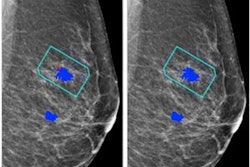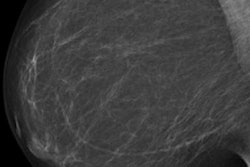
AI is emerging as a promising approach not only to detect breast cancer earlier but also to assess the risk of future breast cancer. Recent evidence from Denmark has shown the vast potential of combining AI systems for short- and long-term breast cancer risk assessment, according to Dr. Filippo Pesapane.
"Diagnostic AI models are proficient at detecting suspicious lesions on mammograms, making them well-suited for estimating short-term breast cancer risk. On the other hand, texture AI models excel at identifying breast density, which is a key factor in assessing long-term breast cancer risk," noted Pesapane, who is a radiologist at the European Institute of Oncology (IEO) in Milan and a member of the AuntMinnieEurope.com editorial advisory board.
In an article posted on 29 August by Radiology, first author Andreas Lauritzen, PhD, from the University of Copenhagen, emphasized the importance of reliable and robust breast cancer risk assessment using information derived from screening mammograms. Achieving this goal can lead to earlier diagnoses, better outcomes, and reduced strain on the healthcare system, particularly in light of the worldwide shortage of specialized breast radiologists.
The study utilized the diagnostic AI tool Transpara, in addition to a texture model developed by the researchers themselves. These AI models were trained separately and then integrated using a three-layer neural network. To assess the efficacy of the combined AI model, a study group comprising over 119,000 women from a breast cancer screening program in the Capital Region of Denmark was analyzed. The average age of the participants in this study group was 59.
"The results of the study were highly promising," Pesapane explained. "The combined AI model, which integrated both the diagnostic and texture models, exhibited significant improvements in breast cancer risk assessment compared to using the individual models alone. This means that the combined model has the potential to offer a more comprehensive assessment of breast cancer risk."
The results of this study suggest that the combination model of texture risk and examination score is the most accurate model for predicting interval and long-term cancers together, and this model could be used to identify women who are at high risk of developing breast cancer and who may benefit from more frequent screening or other preventive measures, he continued.
The combined AI model had the ability to identify women at a high risk of developing breast cancer. Women identified as having the highest 10% combined risk accounted for a substantial portion of interval and long-term cancers: 44.1% and 33.7%, respectively.
The implications of this research are profound, according to Pesapane. "By utilizing AI for the assessment of breast cancer risk from a single mammogram, the potential exists not only to enable earlier cancer detection but also to alleviate the burden on the healthcare system, particularly in the context of the global shortage of specialized breast radiologists."
The authors pointed out that current clinical risk models often involve multiple tests, including blood work, genetic testing, mammography, and extensive questionnaires. "These requirements not only place additional burdens on radiologists but also introduce delays and overhead into the screening process. In contrast, the combined AI model offers risk assessment with the same level of accuracy as clinical risk models but within seconds from the screening, streamlining the process and improving efficiency in the clinic," he added.
"As we journey into the future of breast cancer risk modeling, there is cause for optimism," Pesapane said. "Advances in technology and data analytics are revolutionizing the accuracy of risk assessment, guiding screening and prevention strategies, and ultimately leading to earlier detection and reduced overtreatment."
However, this path forward is not without its challenges. "One challenge is that AI models are only as good as the data they are trained on. This means that it is important to collect and curate high-quality data from a diverse population of women. Another challenge is that AI models can be biased, which can lead to inaccurate risk assessments for certain groups of women."
Overall, the study by Lauritzen et al is a significant advance in the field of breast cancer risk assessment, he pointed out. "As AI technology continues to develop, we can expect to see even more progress in this area in the years to come."
The author's perspective
In the video interview below, Lauritzen spoke with Amerigo Allegretto, associate editor of AuntMinnie.com, on research his team led, which combined a diagnostic AI system and a mammographic texture model for interval breast cancer and long-term breast cancer risk assessment.
This combined approach showed success in the study, achieving higher diagnostic value than either system alone. Lauritzen also talked about future plans for the model and researchers' continued search for AI to improve breast imaging in the era of personalized healthcare.
To view the original article, "Assessing Breast Cancer Risk by Combining AI for Lesion Detection and Mammographic Texture," by Andreas Lauritzen et al, click here.



















